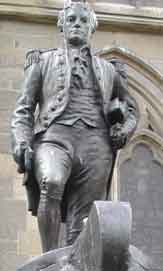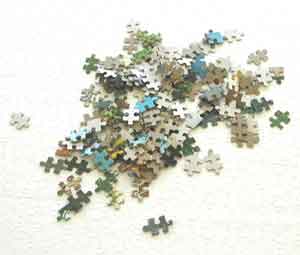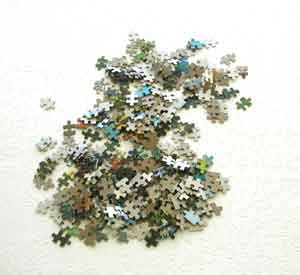Because life is such a puzzle, schools should equip young ones with the skills to weave meaning and reach insight even when confronted by baffling situations, fragments and inconclusive evidence.
As students try to make up their minds about challenging questions, teachers can equip them with several metaphors to illustrate the mental processs required to manage fragments, fog and confusion.
Thanks to Java scripting, there are now quite a few Web sites that can effectively support this visualization. This article explores strategies teachers may employ with these sites to introduce students to such metaphors in ways that will strengthen both their questioning and synthesis skills.
Life is Like a Jigsaw Puzzle
Those who have wrestled with one of those mammoth 2000 piece landscape puzzles during a rain-soaked summer week at the beach know how frustrating it can be once the corners and straight edges have been located and aligned.
Even if you cheat* and look at the picture on the cover of the box, these puzzles can make a grown person cry. (*Some people think that looking at the cover is cheating, but most people I have polled during presentations consider this rational behavior.)
|

Curiosity killed the cat? Since when?
|
Determining the character of an historical figure or figuring out the best treatment for a particular illness can be even more challenging. As with the puzzle, there will be some straight edges and corners that fit into place without much of a struggle, but there will be many gray pieces that defy placement or understanding.
It may prove very difficult to put together an accurate picture of a man or woman from historical times.
In the case of disease, no single treatment choice may come into clear focus as the one right solution. The more information we gather, the harder it may prove to focus or decide. Heaps and heaps of data do not automatically translate into understanding.
In the case of historical figures, the picture on the box (conventional wisdom about the hero or figure) may actually frustrate the search for a real portrait because the man or woman has been lionized or turned into an icon. We have a way of shining up the brass, polishing the marble and overlooking the dark side of historical figures unless they were viewed as traitors, in which case we may exaggerate their dark sides.
The same can be true with medical treatments. Surgeons may portray the knife as the "gold standard" for various cancers in a way that denigrates alternatives. The patient searches the Web for some clarity but finds thousands of articles and reports overwhelming and often contradictory. Truth rarely leaps out from the screen of the computer or the page of the journal in a convincing manner.
Life is a puzzle.
In the next section, we will examine the puzzling metaphor as it applies to Captain Matthew Flinders, the first European to circumnavigate Australia.
What kind of man was Captain Matthew Flinders?



 When we ask students to explore such questions, they learn to map out their inquiry using a program like Inspiration™. The map will start to look a bit like a jigsaw puzzle with its pieces strewn across the table. No clear picture can emerge until dozens of clues and incidents have been collected and organized.
When we ask students to explore such questions, they learn to map out their inquiry using a program like Inspiration™. The map will start to look a bit like a jigsaw puzzle with its pieces strewn across the table. No clear picture can emerge until dozens of clues and incidents have been collected and organized.
As the students read through documents describing events from his life, they collect stories that show character. They attach those incidents on the mind map to the traits they substantiate.
Students may find such incidents at Project Gutenberg's site that shares historical documents such as A Voyage to Terra Australis, by Matthew Flinders. http://www.gutenberg.org/dirs/1/2/9/2/12929/12929-h/12929-h.htm
Scanning through this very long document using the "FIND" function on their browser, they might look for the word "native" to see how he behaved each time he encountered aboriginal people. Was he aggressive? peaceful? patronizing? respectful?
| Quoting from Flinder's account of his voyage . . .
The number of people had increased to near twenty, and others were still coming, so that it was necessary to use all possible expedition in getting out of their reach. But a new employment arose upon our hands: we had clipped the hair and beards of the two Botany Bay at Red Point; and they were showing themselves to the others, and persuading them to follow their example. Whilst, therefore, the powder was drying, I began with a large pair of scissors to execute my new office upon the eldest of four or five chins presented to me; and as great nicety was not required, the shearing of a dozen of them did not occupy me long. Some of the more timid were alarmed at a formidable instrument coming so near to their noses, and would scarcely be persuaded by their shaven friends, to allow the operation to be finished. But when their chins were held up a second time, their fear of the instrument--the wild stare of their eyes--and the smile which they forced, formed a compound upon the rough savage countenance, not unworthy the pencil of a Hogarth. I was almost tempted to try what effect a little snip would produce; but our situation was too critical to admit of such experiments.
|
If they think his joking about snipping native people with his scissors shows cruelty, they might attach a note to that cluster. On the other hand, if they can find stories of friendly and courteous behavior, they may add a new trait to the diagram. As the collection of clues and evidence grows, they can begin to make reasoned judgments.
How is this process like moving around the pieces of a jigsaw puzzle?
Ask your students to visit the JigCard Gallery and wrestle with the puzzle of the day on the right.
http://www.jigcardgallery.com/
How is this kind of puzzling like wrestling with a baffling question?
In what ways does the metaphor work? In what ways does it fail?
How can visualizing jigsaw puzzling help students understand the task of understanding Matthew Flinders or any other historical figure?
|

Daily Jigsaw Puzzle
Displayed with permission.
|
 Someone to look up to?
Someone to look up to?
We often put people like Flinders up on a pedastal, both literally and figuratively. We make statues and we make icons of them. We tend to highlight their virtues while overlooking or forgetting their failings.
While conflict between European explorers and aboriginal peoples was not unusual, some ship captains and their crews did more killing than others. In judging their achievements and their character we might want to look beyond the lands discovered to issues of fairness and humanity.
Historians often celebrate conquest without tallying or addressing the human costs. When our ancestors acted like bullies, we celebrate their bullying while telling students that bullying is bad behavior on the playground. Mixed messages at the least.
In the case of Flinders and his version of his voyage, if students look for the word "kill," what will students find? What if they find reports of his killing animals but not people? What would that show about his character? his leadership?
We must remember, of course, that this is Flinders writing an account of his voyages years after they took place when in captivity. Can we trust his version of the events? For that matter, should students ever rely upon a single source when seeking truth?
What choice do they have in this instance? If no other partipants published written accounts of these events, how can they evaluate the truth of his claims?
Flinders' character certainly is a puzzle - one not easily solved. As we try to judge the character of historical figures, we must often rely upon clues and hints rather than conclusive evidence.
 The Question Mark
The Question Mark 







 When we ask students to explore such questions, they learn to map out their inquiry using a program like Inspiration™. The map will start to look a bit like a jigsaw puzzle with its pieces strewn across the table. No clear picture can emerge until dozens of clues and incidents have been collected and organized.
When we ask students to explore such questions, they learn to map out their inquiry using a program like Inspiration™. The map will start to look a bit like a jigsaw puzzle with its pieces strewn across the table. No clear picture can emerge until dozens of clues and incidents have been collected and organized. 
 Someone to look up to?
Someone to look up to?

